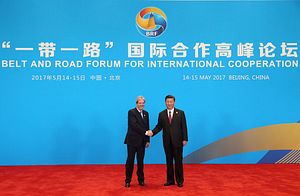Last weekend, Chinese President Xi Jinping hosted hundreds of delegates at the Belt and Road Forum in Beijing. Much has been written in the English-language press about the global geopolitical, geoeconomic, and broader development implications. For Xi, however, what matters most is what the Chinese people think. His and the Communist Party’s continued legitimacy depends on the population’s conviction that the leadership is making good on its core obligations under the tacit social contract post-1989. That is, that politics would be left to the Party in exchange for continued improvements to material well-being, and the fulfillment of the promise to renew China’s status. In this regard, the summit was an unalloyed success, and sets the scene nicely for the upcoming 19th Party Congress.
Chinese media in recent days has been saturated with glowing reports of the summit. This is no surprise, of course, as the media is largely state-owned or at least heavily state-aligned. For example, state-owned People’s Daily and Xinhua coverage emphasized Xi’s speech at the opening of the summit, calling for renewal of the “silk road spirit,” which “serves the common development and shared dreams of all nations for a better future.” The state-funded Global Times quoted foreign leaders’ or media comments praising the Belt and Road Initiative (BRI). News on the state television broadcaster was packed with images of smiling faces and handshakes between Chinese and foreign leaders. State-owned China Daily focused on Xi and his wife, Peng Liyuan, welcoming foreign leaders to Beijing, and the evening gala at the National Center for the Performing Arts. Performances and imagery at the gala were heavy on the historical continuity between the ancient silk road and the BRI.
This reporting complements a barrage of adorable video clips meant to explain the benefits of the BRI to the Chinese people. In a possibly unprecedented Chinese soft power push, one cartoon produced by Fuxing Road Studio, a Chinese studio with a history of pro-government output, shows children from all around the world coming together in celebration of the BRI. Another, entitled “Let’s Go Belt and Road!”, shows how the BRI builds on the great historical tradition of the ancient silk road. In another, aimed at foreign as well as Chinese audiences, and apparently implicitly equating international economic connectivity with Winnie the Pooh or Harry Potter, a father explains the BRI as a bedtime story to his young daughter.
Despite this onslaught of BRI-related material, there has been very little Chinese coverage of the kind seen in Western media in the past few days. There has been no discussion of who attended and who did not, and what this might mean, as has been covered extensively in, for example, The Diplomat. For example, there was no mention that Singaporean Prime Minister Lee Hsien Loong, according to sources privy to the matter, was not invited, despite the fact that seven out of 10 ASEAN heads of state attended, and Singapore may well be one of the biggest advocates of the BRI.
The messaging across all this media fits very neatly with core tenets of Communist Party of China (CPC) legitimacy: material well-being (this is all understood to be “win-win”) and the assurance of China’s renewed glory. The picture painted in the media of China as a benevolent, visionary, expansive (but not expansionist) global power at the center of a web of economic and cultural connections also taps into the influential Chinese worldviews of “history as destiny” and rejuvenation after the “century of humiliation” at the hands of external powers.
The Chinese people’s response to all this cheery reporting, as far as it can be gleaned through social media (which has its limits), is very positive. A lot like the 2008 Olympics, the BRI summit is being read as a symbol of China’s (re-)arrival on the world stage. However, despite reasonable interest, the social contract holds — Chinese netizens’ discussions concentrated on style rather than substance. The topic #BeltandRoadDinner was the most popular issue. Many were also very interested in Xi’s hair (ie, “Our great president must be worrying about the country as he’s got so many grey hairs”); his wife Peng Liyuan’s elegant bearing; and how uncomfortable Russian President Putin looked. Philippines President Duterte also got a mention, but perhaps he may have preferred not to: “Duterte doesn’t have a neck.”
There is no doubt the BRI is an extraordinarily ambitious project. There are many risks to its success. However, its ultimate purpose is to maintain the CPC leadership by demonstrating to the Chinese people that the Party has the things that matter to them under control. In that regard, the Belt and Road Forum has been a huge success, demonstrating to the population that their president is a global statesman with visionary ideas that will change China and the world for the better. This warm glow is a critical victory for the leadership in the lead up to the 19th Party Congress later this year.
Dr. Merriden Varrall is the director of the East Asia Program at the Lowy Institute for International Policy. This article was prepared with the assistance of Wang Zixin, a research assistant at the Lowy Institute.

































